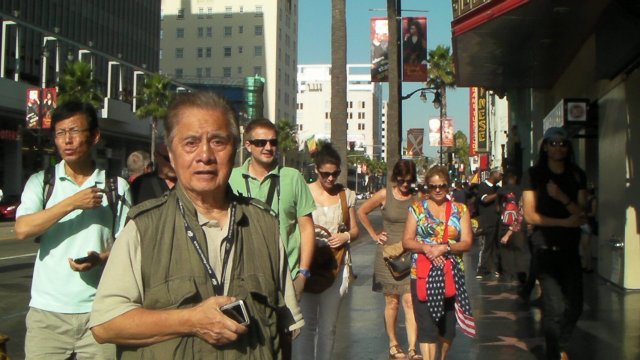Last summer, we finally set foot on Hollywood Boulevard and like most tourists we were looking for “stars” on the famous Walk of Fame. There are thousands of them (some 2,500) for people to step on . . . not for looking up!
We could see a lot of our favourite stars at our feet and we were happily clicking with our digital cameras – Marilyn Monroe, Audrey Hepburn, Gary Grant, Frank Sinatra, Jennifer Lopez, Barbra Streisand . . . and lots of unfamiliar new stars.
This Walk of Fame was first launched in 1960, a who’s-who’s of who’s made it in American entertainment. But unlike, say, the Oscars or the Emmys, the standards for inclusion are kept under tight wraps. So what exactly does it take to get one of these coveted pink terrazzo marble stars?
”It’s a tourist attraction,” says Martinez. ”We want the tourists to come to Hollywood to see their favorite stars.” (And the people working behind-the-scenes to create their favorite entertainment, like directors and producers.) As Di Bona puts it, ”A star lets [fans] say thanks. Thank you for making my life happier or better.”
Briefly, here’s the way to the Stars on the Walk of Fame:
-
Produce something iconic. In theory, anyone can apply for a star – all it takes is mailing an application and a fee to the Hollywood Chamber of Commerce. But submissions won’t even be considered if the candidate isn’t accomplished.
More specifically, that means that star candidates have to be famous for at least five years, and have, as Di Bona puts it, “unchallengeable” expertise in what the Chamber deems a core entertainment category – television, movies, radio, live theatre and music. Reality and Internet stars are notably excluded. As one Chamber rep famously said about Kim Kardashian, “She needs to get a real acting job then come to us.”
Also, no worries if you’re not human (though kudos for being able to read this): animals who have stars include Lassie and Rin Tin Tin, as well as fictional characters like Winnie the Pooh, Mickey Mouse, Donald Duck, and Kermit the Frog.
2. Promise that you want one. All star applications must include a written statement from the star candidate, confirming that they want a star and they will attend the unveiling ceremony if their application is accepted. That’s a main reason why A-listers like Julia Roberts and Dustin Hoffman don’t appear on the Walk of Fame – they’re not interested.
3. Raise $30,000. All star applications carry a $30,000 sponsorship fee. Half goes to the Hollywood Historic Trust, which maintains the Walk of Fame. The rest funds the creation of the star itself – breaking up the blank existing square and replacing it with a new one, printing the replica plaque honorees can take home, hiring photographers, security, and anything else related to the ceremony.
4. Wow the selection committee. Every June, a select group of Hollywood bigwigs meets to review sponsors’ applications – including, most crucially, the star biographies submitted by their personal managers. This is the place to tout key details about awards won, records sold, philanthropic work, and anything else that might sway opinions.
There are six members on the selection committee, all of whom are appointed by the Hollywood Chamber of Commerce and can serve a maximum of two two-year terms. David Green, head of Hollywood’s Pantages Theatre, is the chairman, and only votes if there is a tie.
Stars’ applications are good for two years, but they can reapply as many times as they want.
5. Fight for prime real estate. Historically, the most coveted star placement has been in front of Hollywood Boulevard’s Roosevelt Hotel (where Julio Iglesias, Meryl Streep, Holly Hunter, and Joan Rivers reside) and the Hollywood and Highland shopping center (Sandra Bullock, Nicole Kidman, Susan Sarandon). Now that the Walk of Fame is so big, however, celebrities should consider themselves lucky to get a spot outside the W Hotel, which actually has enough room to accommodate large crowds.
Of course, most of these placements aren’t controlled by the stars themselves. It was Martinez, for example, who put Farrah Fawcett’s in front of George’s Hair Salon in 1995, “because she was so famous for her hair,” she says.Roger Moore, also known as 007, has a star at 7007 Hollywood Boulevard.
But if a star is big enough, he or she may be able to make demands: Muhammad Ali, for example, did not want people stepping on his star, so it was placed on the wall of the Hollywood and Highland shopping center.
Clint Eastwood, if you’re interested, a special place is being reserved for you. “There’s one spot left in front of the Chinese Theatre and we’re saving it,” says Martinez. “He’s been approved, but he never set a date [for the ceremony].”
6. Throw a massive party. Each star is unveiled in a grand ceremony, attended by the stars’ fans and other celebrities. The events typically attract about 600 people. J-Lo’s was on the high end, boasting 1,100 attendees.
When Oscar-winner Marlon Brando came under fire for making anti-Semitic remarks about Jewish people in Hollywood, some said the Godfather actor did not deserve a star anymore. But the late Johnny Grant, former chairman of the Hollywood Walk of Fame committee and the honorary mayor of Tinseltown, argued that celebrities get stars solely on the basis of career merit. After all, as Grant put it (according to Martinez), if stars were pulled up every time a famous person said something stupid, “we would have no stars left.”
 Chinese Theatre – Venue for Academy Awards
Chinese Theatre – Venue for Academy Awards
Garry Miles – “Look For A Star “ (1960)









